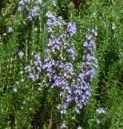This evergreen shrub is native the Mediterranean area where it grows on dry rocky hillsides.  It is a member of the mint family, Lamiaceae, that also includes beebalm, basal, and lavender. Plants grow up to 6′ from a fibrous root system and have scaly bark and gray-green needle-like aromatic leaves 1/3 to 1.5″ long. The pale blue to white flowers are 1/2″ long , two lipped, and appear in clusters of 2 or 3 from late winter to early spring. The ancient Egyptians used rosemary in their burial practices and ancient Greeks students wore sprigs of the herb in their hair to improve memoy while studying. The association of rosemary with good memory persists into modern times with the use of rosemary in tussy mussies as a symbol of remembrance and the use of the herb in bridal bouquets. According to legend, a vigorous rosemary bush means that a woman heads the household. Legends aside, rosemary of one of the most popular culinary herbs and outstanding when paired with garlic and cooked with pork or lamb. Small plants are attractive as minature trees decorated for Chrismas and young plants make good topiary subjects. The genus name, Rosmarinus, comes from the Latin words ros meaning dew, and marinus meaning pertaining to the sea. The specific epithet, officinalis is the Latin word indicating that the plant has medicinal qualities.
It is a member of the mint family, Lamiaceae, that also includes beebalm, basal, and lavender. Plants grow up to 6′ from a fibrous root system and have scaly bark and gray-green needle-like aromatic leaves 1/3 to 1.5″ long. The pale blue to white flowers are 1/2″ long , two lipped, and appear in clusters of 2 or 3 from late winter to early spring. The ancient Egyptians used rosemary in their burial practices and ancient Greeks students wore sprigs of the herb in their hair to improve memoy while studying. The association of rosemary with good memory persists into modern times with the use of rosemary in tussy mussies as a symbol of remembrance and the use of the herb in bridal bouquets. According to legend, a vigorous rosemary bush means that a woman heads the household. Legends aside, rosemary of one of the most popular culinary herbs and outstanding when paired with garlic and cooked with pork or lamb. Small plants are attractive as minature trees decorated for Chrismas and young plants make good topiary subjects. The genus name, Rosmarinus, comes from the Latin words ros meaning dew, and marinus meaning pertaining to the sea. The specific epithet, officinalis is the Latin word indicating that the plant has medicinal qualities.
Type: Evergreen shrub.
Bloom: Small pale blue, white, or pink flowers borne in clusters in early spring.
Leaves: Small, needle like, green upper surface, white hairy below; fine texture.
Size: 5-6’ H x 4-5’ W (outdoors; ‘Tuscan Blue’ to 12’); prostrate cultivars available.
Light: Full sun
Soil: Average, medium moist to dry, well-drained
Fertilizer: None unless the soil is very poor and then only occasionally.
Hardiness: Zones 8-10.
Care: Plant where you want it to stay as rosemary does not transplant well. May be shaped into topiary by trimming away no more than 1/3 the branches and foliage.
Pests and Diseases: May develop root rot if over watered.
Propagation: Cuttings (seeds possible but difficult and results in inferior plants)
Outstanding Selections:
 R. officinalis alba (white flowers, good bloomer, and the hardiest)
R. officinalis alba (white flowers, good bloomer, and the hardiest)
 R. officinalis ‘Rex’ (blue flowers, good bloomer, black-green leaves)
R. officinalis ‘Rex’ (blue flowers, good bloomer, black-green leaves)
 R. officinalis ‘Majorca Pink’
R. officinalis ‘Majorca Pink’
 R. officinalis var. prostrates (prostrate, deep blue flowers)
R. officinalis var. prostrates (prostrate, deep blue flowers)
